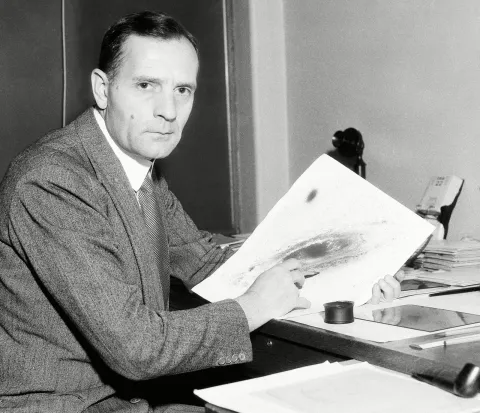Occupation
Astronomer, Cosmologist
Year born
1889
Research Areas
Galaxies, Extra-galactic astronomy, Observational cosmology
"I chucked the law for astronomy, and I knew that even if I were second-rate or third-rate, it was astronomy that mattered."
Source: 'Edwin Powell Hubble: 1889—1953', Memoirs of the National Academy of Sciences (1970), Vol. 41, 179.

- Early Life
Edwin was born in Missouri, USA. As a child, he enjoyed reading science fiction books. When he won a scholarship to the University of Chicago, his father wanted him to study law, not astronomy. Following college, Edwin worked as a high school teacher and basketball team coach.
Edwin retained the love of science and space he had had as a child. In his 20s, he went back to college to study astronomy. At the age of 28, he completed a PhD in the subject. Soon after, Edwin joined the US Army and served a tour of duty during the First World War. In 1919 Edwin, now aged 30, was offered a job at the Carnegie Institution for Science's Mount Wilson Observatory.
- Career Highlights
Edwin used the telescope at Mount Wilson to prove that other galaxies existed outside the Milky Way. Before this, the entire Universe was thought to exist within our galaxy. To do this, he compared the brightness of Cepheid variable stars in several nebulae. These are a kind of star that can be used to work out the distance to a location in space.
Hubble's data showed that the Andromeda 'nebula' was nearly 900,000 light-years away from the Milky Way. It had to be its own galaxy. This discovery led the way for extragalactic astronomy. In 1925, the nebula was renamed the Andromeda Galaxy. Later work showed it to actually be much further away. Nearly 2.5 million light-years away!
Hubble kept on studying and learning more about galaxies. When he was 37, he created a way to group galaxies into categories or classes based on their shape. Around the same time, he began to try to work out why most galaxies seemed to be moving away from Earth. To do so, Edwin and another astronomer, Milton Humason, measured the spectral shift of galaxies. (The faster a galaxy is moving away from us, the more its light is red-shifted by the time it reaches us.)
In 1928, Edwin and Milton published their work. In it, they showed the redshift of the light from a galaxy is directly linked to the distance of the galaxy from Earth. This is now known as Hubble’s Law and is part of the evidence for the continuing expansion of the Universe.
Hubble continued to work at Mount Wilson until his death in 1953 aged 63
- Legacy
NASA named the Hubble Space Telescope in Edwin's honour.
There is also an asteroid, and a crater on the Moon called Hubble.
- Other Interests
Edwin was good at sports and played baseball and football at high school and college. He also won several medals in running track events.
